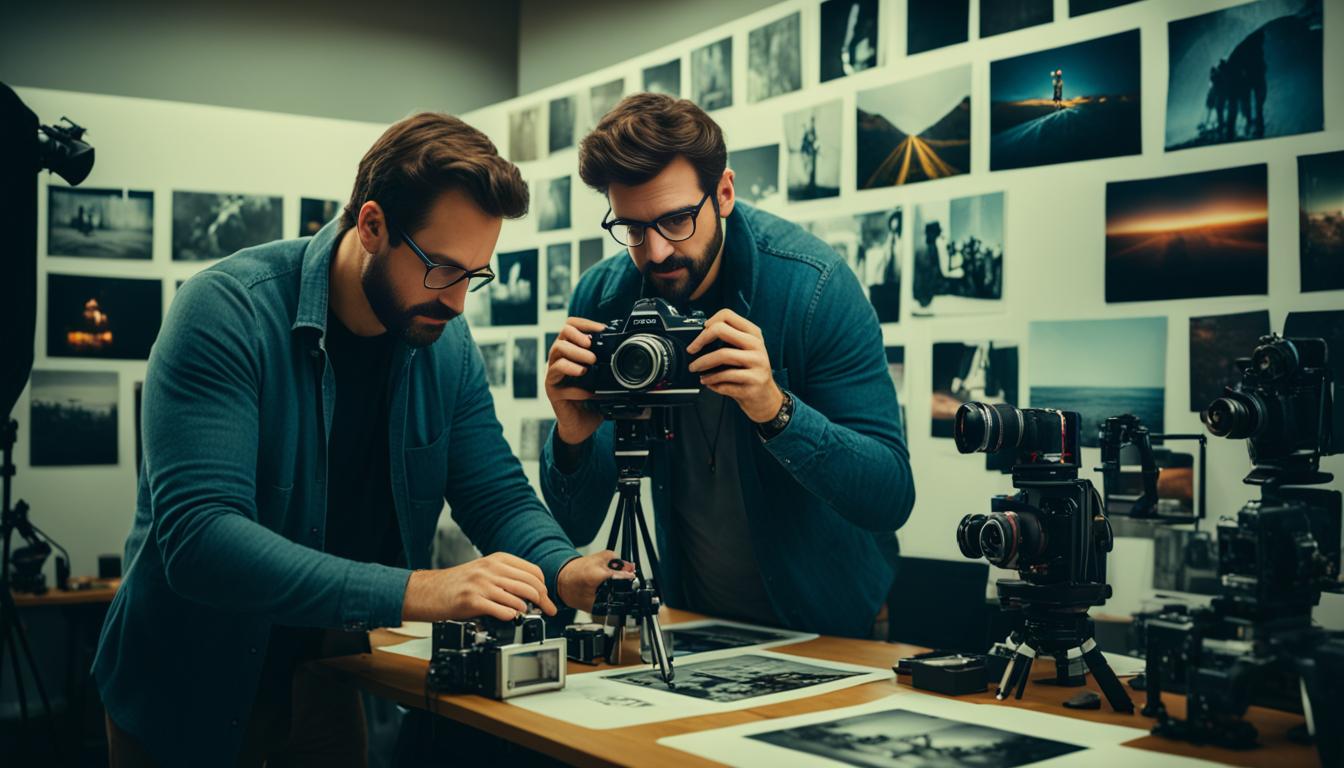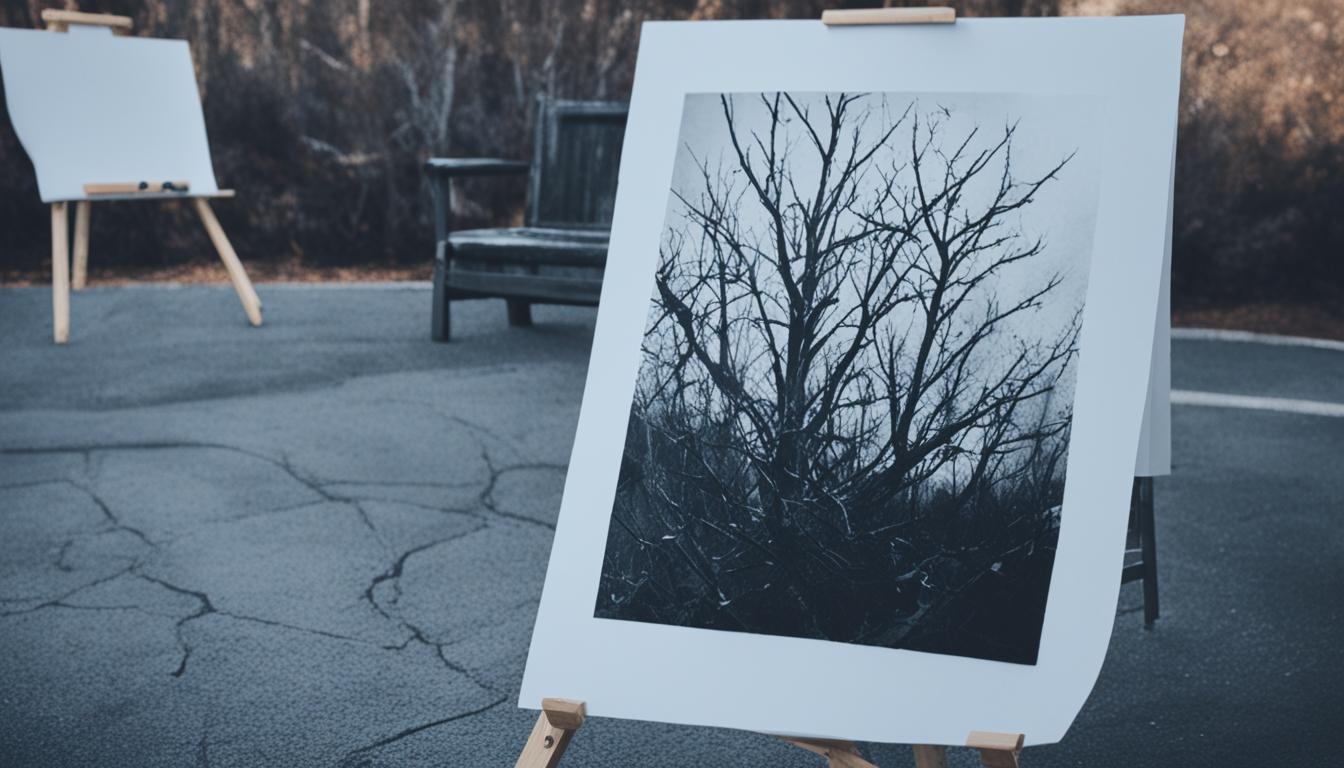Collaboration is a vital aspect of the creative process in fine art photography. Artists that collaborate often find inspiration and new ideas through their partnerships. Famous collaborations, such as the one between Andy Warhol and Jean-Michel Basquiat, have resulted in iconic artworks that have shaped the art world. Other examples include Jasper Johns and Robert Rauschenberg, Marcel Duchamp and Man Ray, and Pablo Picasso and Gjon Mili. These collaborations demonstrate the power of teamwork and the unique creations that can arise from working together in the world of fine art photography.
Key Takeaways:
- Collaboration is essential in fine art photography to gather inspiration and generate new ideas.
- Famous collaborations have resulted in iconic artworks that have influenced the art world.
- Examples include partnerships between Andy Warhol and Jean-Michel Basquiat, Jasper Johns and Robert Rauschenberg, Marcel Duchamp and Man Ray, and Pablo Picasso and Gjon Mili.
- The power of teamwork in fine art photography can lead to the creation of unique and groundbreaking works.
- Collaborations in fine art photography continue to shape the art world and inspire future generations of artists.
The Impact of Andy Warhol and Jean-Michel Basquiat’s Collaboration
Andy Warhol and Jean-Michel Basquiat formed a remarkable artistic partnership that spanned from 1980 to 1986. Their collaboration resulted in a series of exhilarating artworks that melded the worlds of Pop art and graffiti. This fusion of artistic styles and ideas became a hallmark of their collaborative work.
Warhol, already an established figure in the art world, provided a platform for Basquiat’s raw and vibrant imagery, exposing Basquiat to a broader audience. In turn, Basquiat brought a fresh perspective and energy to Warhol’s iconic approach. Their collaboration was a symbiotic exchange, a visual conversation carried out with paint and brushes.
One of the notable pieces from their collaboration is “Olympic Rings” created in 1985. This artwork exemplifies the dynamic nature of their partnership, with Warhol’s signature style serving as the backdrop for Basquiat’s expressive and colorful brushstrokes.
“Working with Andy has been sensational. He’s a force, and I’m learning from him every day. I hope I’m giving him a little something, too.” – Jean-Michel Basquiat
The collaboration between Warhol and Basquiat transcended the boundaries of traditional artistic practices. It brought together two diverse artistic perspectives and propelled them into a new realm of artistic exploration. Their partnership challenged the status quo and continues to influence and inspire artists today.
| Collaborative Artwork | Year |
|---|---|
| “Olympic Rings” | 1985 |
| “Warhol Basquiat” | 1985 |
| “Arm and Hammer II” | 1984 |
| “Ten Punching Bags (Last Supper)” | 1985 |
Table: Collaborative Artworks by Andy Warhol and Jean-Michel Basquiat.
The Influence of Jasper Johns and Robert Rauschenberg’s Collaboration
Jasper Johns and Robert Rauschenberg were influential artists in the American neo-Dada movement. Their collaboration was a testament to their shared vision and artistic partnership. By exchanging ideas and techniques, they had a significant impact on each other’s work and the art movement as a whole.
Johns’ concept of the “combine” technique was particularly influential in Rauschenberg’s paintings. This technique involved incorporating found objects and everyday materials into artwork, blurring the boundaries between fine art and mass culture. It allowed Rauschenberg to create multidimensional and thought-provoking pieces that challenged traditional artistic norms.
To illustrate their collaboration, two notable works stand out: Rauschenberg’s “Bed” and Johns’ “Target with Four Faces.” “Bed” (1955) was an assemblage artwork where Rauschenberg combined his own quilt, pillow, and sheet, transforming them into a work of art. This piece challenged the notion of what could be considered art and influenced future generations of artists.

Johns’ “Target with Four Faces” (1955) showcased his fascination with everyday symbols and their underlying meanings. In this artwork, he used the iconic target motif to explore themes of identity and perception. This piece is a testament to the power of collaboration and the influence of artistic partnership.
In conclusion, the collaboration between Jasper Johns and Robert Rauschenberg had a profound impact on the art world. Their exchange of ideas and the innovative techniques they developed pushed the boundaries of traditional art forms. Their partnership helped to shape the American neo-Dada movement, blurred the lines between fine art and mass culture, and paved the way for the emergence of the Pop Art movement.
The Artistic Collaboration of Marcel Duchamp and Man Ray
Marcel Duchamp and Man Ray, two prominent figures in the Dada movement, formed a profound artistic friendship that resulted in a fruitful art collaboration. Their collaboration spanned across various mediums, showcasing their shared artistic vision and experimental nature.
One of the notable works to arise from their collaboration is the film “Anemic Cinema,” created together in 1926. This groundbreaking film featured rotating text spirals, displaying their innovative approach to artistic expression.
However, their collaboration extended beyond artistic projects. Man Ray captured Duchamp in his female alter ego, Rrose Sélavy, through a series of photographs. These iconic images merged their distinct artistic styles, highlighting the depth and complexity of their artistic synergy.
Duchamp and Ray’s collaboration exemplified their commitment to pushing artistic boundaries and challenging traditional norms. Through their partnership, they contributed to the development of the Dada movement and left an indelible mark on the art world.
Overall, the artistic collaboration between Marcel Duchamp and Man Ray serves as an exemplary testament to the power of creative partnerships and the transformative potential that emerges when artists join forces. Their shared vision and unwavering commitment to experimentation continue to inspire and influence the art world to this day.
Conclusion
Collaboration has long been a driving force in the world of fine art photography, allowing artists to forge artistic partnerships and embark on creative collaborations that have a lasting impact. Through collaborative art projects, photographers have been able to push the boundaries of their individual artistic visions, resulting in groundbreaking and innovative artworks.
Artistic partnerships, such as the collaboration between Andy Warhol and Jean-Michel Basquiat, have shown us the power of teamwork and the fusion of different artistic perspectives. Their collaboration brought together Warhol’s iconic pop art style and Basquiat’s graffiti-influenced imagery, creating a new artistic movement that transcended traditional boundaries.
Similarly, the collaboration between Jasper Johns and Robert Rauschenberg, and the artistic friendship of Marcel Duchamp and Man Ray, have demonstrated the transformative power of collaboration. These artists shared techniques, ideas, and inspirations, leading to the development of new artistic movements and influencing generations of artists to come.
As we continue to witness the impact of collaborations in fine art photography, it is clear that these creative partnerships foster an environment of inspiration and learning. They encourage artists to think outside the box, experiment with new techniques, and challenge conventional norms. The result is a diverse and dynamic body of work that enriches the art world and inspires future generations of photographers.
FAQ
How does collaboration impact the creative process in fine art photography?
Collaboration is a vital aspect of the creative process in fine art photography. Artists that collaborate often find inspiration and new ideas through their partnerships. Collaborations allow artists to inspire and learn from one another, resulting in innovative and diverse creations.
What are some famous collaborations in the world of fine art photography?
Some famous collaborations include the partnership between Andy Warhol and Jean-Michel Basquiat, Jasper Johns and Robert Rauschenberg, and Marcel Duchamp and Man Ray. These collaborations have resulted in iconic artworks that have shaped the art world.
Can you provide examples of successful collaborations in fine art photography?
Examples of successful collaborations include Andy Warhol and Jean-Michel Basquiat’s collaboration, which resulted in artworks like “Olympic Rings.” Another example is the partnership between Jasper Johns and Robert Rauschenberg, which influenced the American neo-Dada movement with works such as “Bed” and “Target with Four Faces.” Additionally, Marcel Duchamp and Man Ray collaborated on various artistic projects, including the creation of the film “Anemic Cinema.”
How do collaborations in fine art photography shape the art world?
Collaborations in fine art photography have a significant impact on the art world. They blur boundaries between art movements and influence future generations of artists. Collaborations allow for the exchange of ideas and techniques, resulting in unique and groundbreaking artworks.
Why are collaborations important in fine art photography?
Collaborations are important in fine art photography because they foster creativity, provide fresh perspectives, and push boundaries. Artists in partnerships can challenge and learn from one another, leading to innovative and diverse artistic creations.
How Can Collaborations Impact the Future Trends of Fine Art Photography?
Collaborations play a crucial role in exploring fine art photography trends. Working with other artists brings fresh perspectives, innovative techniques, and diverse influences. It can lead to groundbreaking creativity, pushing the boundaries of traditional fine art photography and shaping future trends in the industry.




